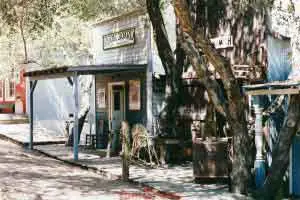Elwin Mussell came to Santa Maria as a 16-year-old. He learned printing and produced a free newspaper called the Santa Maria Advertiser. Over time, he came to own close to 574 acres of land in Ruiz Canyon. He also served as city mayor from 1974 to 1980.
In 1952, Mussell started building a “fort,” designed to be a personal showplace. Most of the property was purchased from Fred Gobel in the 1940s. Additional property was purchased from a man named Livingston, a direct descendant David Livingston from Africa.
Mussell died in a car accident in May of 1980; he was returning from the fort. His wife, Barbara, died 11 days later from an extended illness.
Mussell Fort was sold in 2001. The new owners are the Knight Family (Len, Dorothy, Matt, and Cecilia). It can be used by non-profit organizations for events. The Knights can be contacted at (805) 934-3577.
Mussell Fort is located on private land off of Tepusquet Canyon Road, north of Santa Maria.
Despite giving you the location here, it is important that you NOT try to find the fort without a specific invitation from the owner. If you trespass you may be subject to legal action.
[Photos on this page can be enlarged by clicking on them. Click outside the photo to close the box it displays in.]
The fort became a small version of a western town built up of buildings and furnishings obtained from historical sites in and around the area. The collection is nothing more than a full living museum.
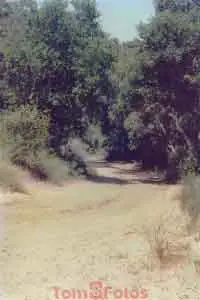 These pictures come from a 1996 fund raiser for the Santa Maria Historical Society that was held at the fort. The road into the fort was originally a trail blazed by Douglas Mussell using hand tools on weekends and during vacation from junior high school.
These pictures come from a 1996 fund raiser for the Santa Maria Historical Society that was held at the fort. The road into the fort was originally a trail blazed by Douglas Mussell using hand tools on weekends and during vacation from junior high school.
Building started in 1952. The kitchen and an outhouse were the first constructed on the site. A fire, however, swept through the area in 1953. The kitchen, built out of green redwood, was scorched but the outhouse burned. Elwin was fond of saying the outhouse burned but “he saved the hole.”
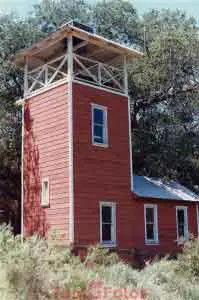 As you might expect, after the fire a Fire Tower was built to allow for observing the local area for smoke and to store fire fighting equipment. Designed after a 36-foot tower in the Mother Lode country, the floors are tongue and groove boards brought from a Santa Maria ice house that was demolished.
As you might expect, after the fire a Fire Tower was built to allow for observing the local area for smoke and to store fire fighting equipment. Designed after a 36-foot tower in the Mother Lode country, the floors are tongue and groove boards brought from a Santa Maria ice house that was demolished.
This set the stage for how much of the fort was constructed. Materials taken from other sites and brought to the fort make the fort the living museum that it is.
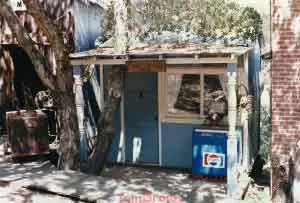 A variety of stores line the main street of the fort. Each contains a wide collection of artifacts from locations around the southwest in addition to the Central Coast.
A variety of stores line the main street of the fort. Each contains a wide collection of artifacts from locations around the southwest in addition to the Central Coast.
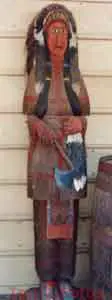 The General Merchandise Store is at the bottom end of the main street and visitors there are greeted by a hand-carved wooden Indian. In the store you will see a wide variety of household items. The flour, sugar, and grain bins came from the first grocery store in Morro Bay.
The General Merchandise Store is at the bottom end of the main street and visitors there are greeted by a hand-carved wooden Indian. In the store you will see a wide variety of household items. The flour, sugar, and grain bins came from the first grocery store in Morro Bay.
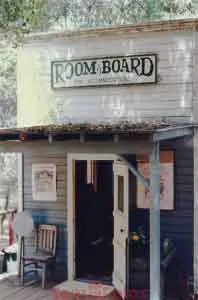 Among the buildings are a Barber Shop and Board & Room house. The Board & Room house has a brass double bed and 1924 Hamilton Manuelo player piano. This latter was the first player piano Douglas Mussell obtained for his now extensive collection of player pianos. Paintings on the walls are all originals by local artists.
Among the buildings are a Barber Shop and Board & Room house. The Board & Room house has a brass double bed and 1924 Hamilton Manuelo player piano. This latter was the first player piano Douglas Mussell obtained for his now extensive collection of player pianos. Paintings on the walls are all originals by local artists.
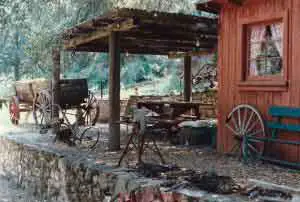
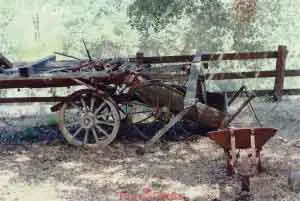 Elwin collected everything. In the Blacksmith Shop the bellows and some tools came from the Jefferson Gold and Silver Mine northeast of Tonopah, Nevada. Copper soldering irons and a forming cones come from the Froom Tank Company in Santa Maria and date from 1900 to the 1940s. Branding irons from across the West cover the ceiling.
Elwin collected everything. In the Blacksmith Shop the bellows and some tools came from the Jefferson Gold and Silver Mine northeast of Tonopah, Nevada. Copper soldering irons and a forming cones come from the Froom Tank Company in Santa Maria and date from 1900 to the 1940s. Branding irons from across the West cover the ceiling.
One of the buildings moved to the fort from Santa Maria had to be cut in sections and reassembled at the fort. There is even a Saloon (with the traditional swinging doors). The signed Franklin Delano Roosevelt photos that adorn the walls bring back memories of Mussell’s active campaigning on behalf of the Democratic Party. The signed card from “Death Valley Shorty,” is definitely one of a kind.
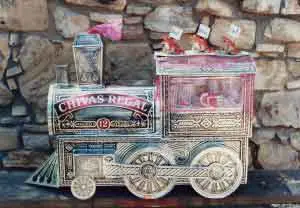 Nothing was wasted. Even the empties and boxes were saved and used as seen here.
Nothing was wasted. Even the empties and boxes were saved and used as seen here.
Colophon
All photographs on this page were taken in 1996 on Kodak Gold-400 print film. The prints were scanned to convert them to digital for presentation here.
[This page was moved from my TomsDomain.com site to TomsFotos 27 Feb 2014.]
![]()
